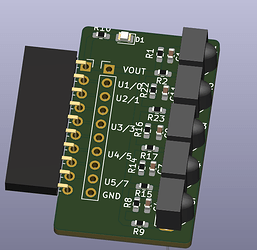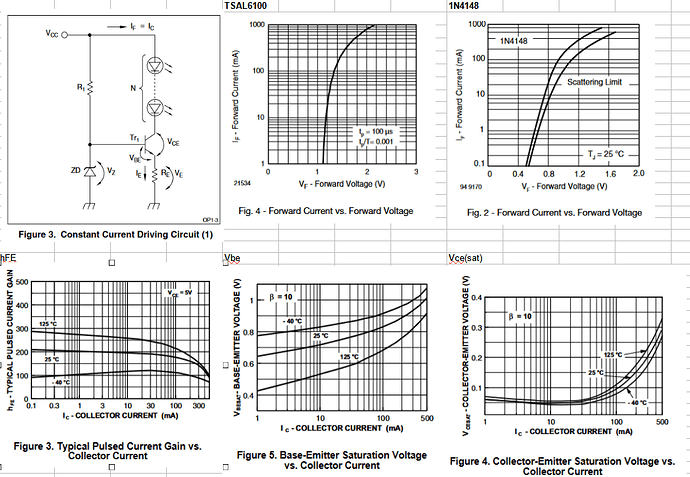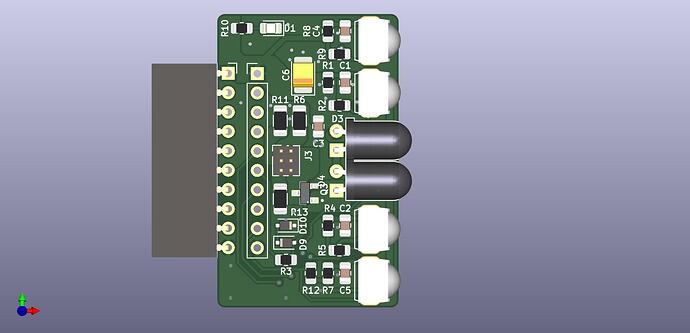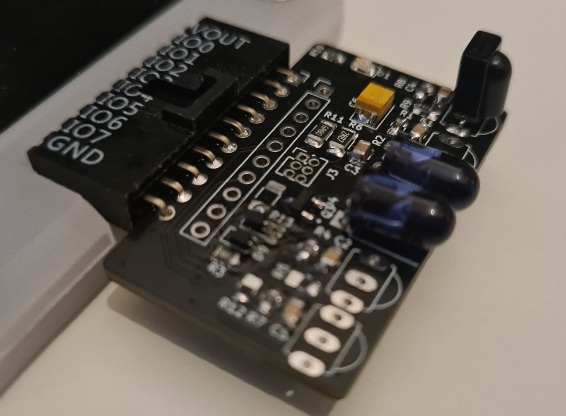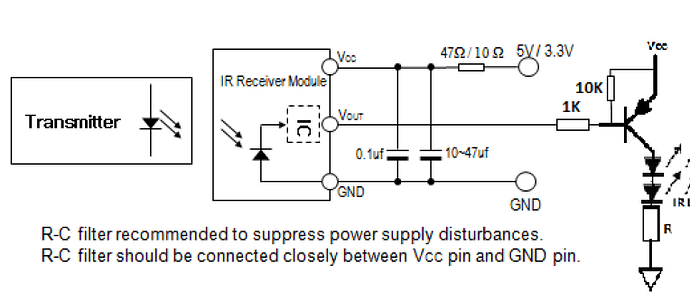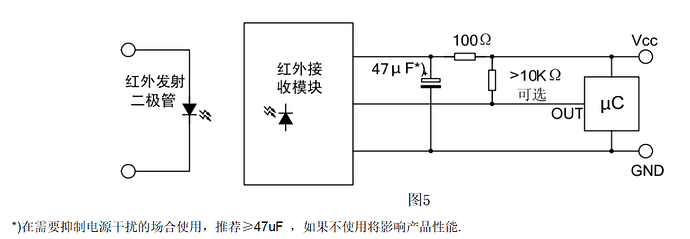|
Model |
Frequency |
Typical Application |
Note |
Everlight |
Opti-fake |
| Vishay |
TSSP4038 (3元) |
38kHz |
Barrier |
Widely Available |
IRM-3638T (0.78元) |
|
| Vishay |
TSMP58000 |
20 → 60kHz |
Learner |
Obsolete |
|
OS1200MW-A1 (3元) |
| Vishay |
TSMP98000 (7元) |
20 → 60kHz |
Learner |
New TSMP58000 |
|
|
| Vishay |
TSOP34436 (8元) |
36kHz |
RC5/6 |
|
|
|
| Vishay |
TSOP34438 (8元) |
38kHz |
NEC |
|
IRM-3638J7(1.6元) |
OS-883YM-MS (1.2元) |
| Vishay |
TSOP4840 (5元) |
40kHz |
SONY |
|
|
|
| Vishay |
TSOP2256 (5元) |
56kHz |
RCA |
EOL |
|
|
Table of findings, prices in RMB (元).
Thank you @henrygab for spotting the updated part number for the TSMP58000 (TSMP98000), and for suggesting to contact Chris at AnalysIR.
Recommendations
Chris is an expert in this area, and he was kind enough to make some recommendations:
IR LEDs:
- TSAL6100 (10 degrees)- we use this the most or pair with the next if 2 LEDs are installed.
- TSAL6200 (17degrees)
- TSAL6400 (25 degrees)
All similar with just different emission angles.
Remotes use circa 300mA peak - we use jumper selectable resistors to allow varying the current up to 300-400ma.
IR Receivers Modulated output:
- 20-60 kHz - TSMP58000 (EOL but use the direct replacement that has a smaller bandwidth)
IR Receivers demodulated output:
- 38kHz (& 36kHz, 40kHz) - TSSP4038 - we find this works better for wider frequency range from a single receiver
- 38kHz (& 36kHz, 40kHz) - TSOP34428 (rejects some out-of-bounds signals)
The 2 options above will have you covered - but your pick…for a testing device(like BPV5) you don’t really need an AGC as the environment can be controlled…but for commercial deployment of end user devices you would need to match up the AGC & protocol very closely.
Thoughts
I was considering 3 or 4 LEDs, but now I’m backing off that. One narrow (TSAL6100) and one wider (TSAL6200,TSAL6400) LED in series on a single driver is board space and design friendly.
TSMP58000/TSMP98000 passes along the actual modulated raw signal if the modulation frequency is between 20kHz and 60kHz. This is useful for measuring the modulation frequency for cloning/copying (learning) a signal. The USB IR Toy used the QSE159 for this, but it doesn’t reject any frequencies so is a lot noisier.
The center spaced 38kHz demodulators will also handle 36kHz and 40kHz in low noise environments. This worked a treat on the USB IR Toy for years with no major incompatibilities. With Chris’ confirmation, I don’t think dedicated 36kHz and 40kHz demodulators are needed.
- TSSP4038 is a ‘barrier’ type, meaning it activates when hit with a 38kHz modulated IR light for any length of time. Useful for odd protocols, but needs a lot of software processing.
- TSOP34428 adds a tiny bit of logic that rejects signals that are too long or too short (rejecting buzz from florescent lamps, etc), so it is more likely to trigger on a valid signal.
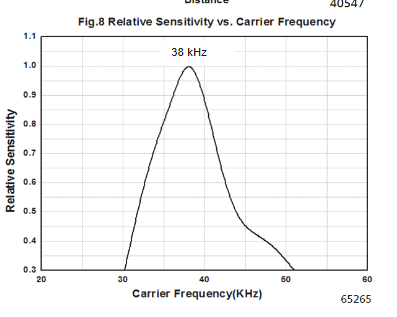
56kHz is where I’m tempted to depart from Chris’ recommendation. While 38kHz is still 85-90% responsive to 36kHz and 40kHz signals (as shown in the chart), it really does nothing for 56kHz signals. Now, in my experience 56kHz remote signals are rare, but so are micro SIM cards and we included that on the SIM card adapter. If feasible, I’d like to include a 56kHz demodulator.
Sourcing
Vishay
We’re in this weird no man’s land for the Vishay parts. Just about everything except the 38kHz parts are part of a custom run. Vishay distributors have very little of anything (“None of that’s in China”), so we turn to the part ‘scalpers’ who dig up little bits of end runs from other manufacturers’ projects.
- If we were doing 10K TVs, a Vishay distributor would work with Vishay to import MOQ, or make a part to spec that isn’t normally stocked.
- If we were doing 1, 10 or even a one-off of 100, we could use the limited supply available through the scalpers and not worry about long term availability
- We’re shooting for batches of 100 on a regular basis though, so we’re too small for a custom run but need more long term stability than the scalpers can supply.
- TSSP4038 is the only part that is consistently available on the market in reliable quantities.
Everlight
In this situation I usually hunt for the “next best local option” that is either manufactured locally, or is widely available in China. In this case that is Everlight. Here’s the deal with Everlight:
- Tons of distributors! This stuff is available everywhere cheap, where as Vishay is just scraps.
- However! The distributors have no idea what any of it is. They can’t recommend equivalent part numbers, and they don’t have datasheets.
- Everlight has a nice website, but the product pages don’t actually have any product listings! They list distributors world wide, but without contact info! there’s no QQ or WeChat link to talk to them. They defo don’t want to deal with us.
- I can find some old (2004-2020) catalogs, but the catalog just lists part numbers without specs…
- I’m left making my best guess based on parts available at szlcsc and the dodgy dated datasheets they have available for some parts.
My best guess is that IRM-3638T is equivalent of TSSP4038. IRM-3638J7 seems like a light-touch rejection demodulator like the TSOP34438. I bought samples of both and will compare them to the Vishay parts with a scope. The important part is these are widely available.
Opti-fake
Now, let’s talk about Opti-fake. We were looking for a sample of the TSMP98000 (new/updated TSMP58000). Opti-fake is a Vishay distributor and lists the part on 1688, so we make an inquiry. The response is basically “psst psst, add me on WeChat”, we’re now following a guy down a back alley.
The rep sends us datasheets for their “own version” TSMP98000 (OS1200MW-A1) and TSOP34438 ( OS-883YM-MS). We got samples of both, and will compare to Vishay parts with a scope.
Scalpers
Finally, that 56kHz demodulator. The scalpers can get TSOP2256. I don’t know how steady the supply will be, but I’m inclined to include it and hope we build a relationship over a few batches that gives us better access.
Next steps
I realize this is a wall of text, but it is also my notes for the eventual hardware design documentation 
We tried to get 5 samples of each sensor. They will arrive to the Shenzhen office early next week, and make it to me a week after that. If there are enough to go around, I’m happy to mail some out to anyone who is interested in playing along.

